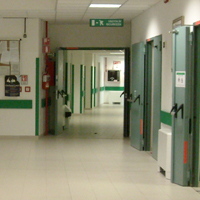Fall Risk Assessment Tools
Validity Considerations and a Recommended Approach

All claims expressed in this article are solely those of the authors and do not necessarily represent those of their affiliated organizations, or those of the publisher, the editors and the reviewers. Any product that may be evaluated in this article or claim that may be made by its manufacturer is not guaranteed or endorsed by the publisher.
Authors
Falls in hospital are common and have serious consequences for patients, including physical and psychological harm, increase length of stay and hospital costs. A systematic approach is required to report and identify factors contributing to in-hospital falls and develop interventions to reduce inpatient fall rates. Different hospital settings have different fall rates and characteristics depending on type of hospital service and admission diagnosis. Screening tools were developed to assess fall risk but are usually insensitive to be useful in reducing falls. There is also a need for prospective validation in each hospital setting to ensure accuracy, resulting in a move away from using such scoring tools. A recommended approach for fall risk assessment is given, which integrates the process for outpatient settings and inpatients.
2. Mahoney J. Immobility and falls in the acute care setting. Clin Ger Med 1998;14:699-72.
3. Boushon B, Nielsen G, Quigley P, Rita S, Rutherford P, Taylor J, Shannon D, Rita S.
Transforming Care at the Bedside How-to Guide: Reducing Patient Injuries from Falls.
Cambridge, MA: Institute for Healthcare Improvement; 2012. Available at: www.ihi.org.
4. Wu S, Keeler E, Rubenstein L, et al. A cost-effectiveness analysis of a proposed national falls prevention program. Clinics in Geriatric Medicine. 2010;26(4):751-766.
5. Joint Commission International. Joint Commission International for Accreditation Standards for Hospitals. 6th Ed JCI. United States of America: JCRINC; 2017. 355p.
6. Healey F, Scobie S, Oliver D, Pryce A, Thomson R, Glampson B. Falls in English and Welsh hospitals: a national observational study based on retrospective analysis of 12 months of patient safety incident reports. BMJ Qual Saf 2008;17:424-30. doi: 10.1136/qshc.2007.024695
7. Hitcho EB, Krauss MJ, Birge S, et al. Characteristics and circumstances of falls in a hospital setting. A prospective analysis. J Gen Int Med 2004;19(7):732-39.
8. Rohde JM, Myers AH, Vlahov D. Variation in risk for falls by clinical department: implications for prevention. Infect Control Hosp Epidemiol 1990;11(10):521-24. DOI: https://doi.org/10.2307/30151319
9. Krauss MJ, Nguyen SL, Dunagan WC, Birge S. Circumstances of Patient Falls and Injuries in 9 Hospitals in a Midwestern Healthcare System. Infect Control Hosp Epidemiol 2007;28(5):544-50. doi: 10.1086/513725
10. Hill KD, Vu M, Walsh W. Falls in the acute hospital setting - impact on resource utilisation. Austral Health Rev 2007;31(3):471-77. doi: 10.1071/AH070471
11. Brand CA, Sundararajan V. A 10-year cohort study of the burden and risk of in-hospital falls and fractures using routinely collected hospital data. Qual Saf Health Care 2010;19:e51. doi: 10.1136/qshc.2009.038273
12. Vassallo M, Stockdale R, Sharma JC, Briggs R, Allen S: A comparative study of the use of four fall risk assessment tools on acute medical wards. J Am Geriatr Soc. 2005, 53: 1034-1038. doi: 10.1111/j.1532-5415.2005.53316.x.
13. Haines TP, Hill K, Walsh W, Osborne R. Design-Related Bias in Hospital Fall Risk Screening Tool Predictive Accuracy Evaluations: Systematic Review and Meta-Analysis. J Gerontol A Biol Sci Med Sci 2007;6:664-72. doi: 10.1093/gerona/62.6.664
14. Aranda-Gallardo M, Morales-Ascensio JM, Canca-Sanchez JC, et al. Instruments for assessing the risk of falls in acute hospitalised patients: a systematic review and meta-analysis. BMC Health Serv Res 2013;13:122. doi: 10.1186/1472-6963-13-122
15. Oliver D, Papaioannou A, Giangregorio L, et al. A systematic review and meta-analysis of studies using the STRATIFY tool for prediction of falls in hospital patients: how well does it work? Age Ageing 2008;37(6):621-7. doi: 10.1093/ageing/afn203
16. Kim EAN, Mordiffi SZ, Bee WH, Devi K, Evans D: Evaluation of three fall-risk assessment tools in an acute care setting. J Adv Nurs. 2007, 60: 427-435. doi: 10.1111/j.1365-2648.2007.04419.x.
17. Hendrich AL, Bender PS, Nyhuis A, Validation of the Hendrich II Fall Risk Model: A large concurrent case/control study of hospitalised patients. Appl Nurs Res 2003;16(3):208
18. Chow SK, Lai CK, Wong TK, et al. Evaluation of the Morse Fall Scale: Applicability in Chinese hospital populations. Int J Nurs Studies 2007;44(4):556-65.
19. Papaioannou A, Parkinson W, Cook R, Ferko N, Coker E, Adachi JD. Prediction of falls using a risk assessment tool in the acute care setting. BMC Med 2004;2:1. doi: 10.1186/1741-7015-2-1
20. Walsh W, Hill KD, Bennell K, Vu M, Haines TP. Local adaptation and evaluation of a falls risk prevention approach in acute hospitals. Int J Qual Health Care 2011;23(2):134-141. doi: 10.1093/intqhc/mzq075
21. Oliver D, Daly F, Martin FC, McMurdo ME. Risk factors and risk assessment tools for falls in hospital in-patients: a systematic review. Age Ageing 2004;33(2):122-130. doi: 10.1093/ageing/afh017
22. Oliver D. Falls risk-prediction tools for hospital inpatients. Time to put them to bed? Age Ageing 2008;37(3):248-50. doi: 10.1093/ageing/afn088
23. Oliver D, Healey F. Falls risk prediction tools for hospital inpatients: do they work? Nurs Times 2009;105:7,18-21.
24. Stevens JA, Phelan EA. Development of STEADI: a fall prevention resource for health care providers. Health Promot Pract 2013;14:706-14.
25. Stevens JA. The STEADI Toolkit: a fall prevention resource for health care providers. IHS Prim Care Provid 2013;39:162-66.
26. Practicing Physician Education in Geriatrics. Get Up and Go Test. [Internet].2006. [cited 2019 July 7]. Available from: http://www.gericareonline.net/tools/eng/falls/attachments/Falls_Tool_2_Get_Up_and_Go_Test.pdf
27. Agency for Healthcare Research and Quality (AHRQ). Preventing Falls in Hospitals. [Internet]. 2018. [cited 2019 July 7]. Available from: https://www.ahrq.gov/professionals/systems/hospital/fallpxtoolkit/index.html
28. Haines TP, Bennell KL, Osborne RH, Hill KD. A new instrument for targeting falls prevention interventions was accurate and clinically applicable in a hospital setting. J Clin Epidemiol 2006;59(2):168-75. doi: 10.1016/j.jclinepi.2005.07.017
How to Cite
PAGEPress has chosen to apply the Creative Commons Attribution NonCommercial 4.0 International License (CC BY-NC 4.0) to all manuscripts to be published.






